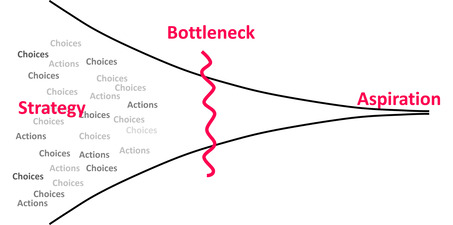 Peter Compo, in his book The Emergent Approach to Strategy, introduces the Strategy Triad—a simple but powerful way to begin strategy design.
Peter Compo, in his book The Emergent Approach to Strategy, introduces the Strategy Triad—a simple but powerful way to begin strategy design.
The Three Elements of the Strategy Triad
It helps organisations focus on what truly matters by focusing on the three most important components of their strategy framework.
Aspirations
These are your organisation’s desired future state(s)—expressed in StratNavApp.com as Goals or a Vision or Mission statement—what you want to achieve. Aspirations set the direction for the future, but they are not enough on their own. To succeed, you also need to identify what’s holding you back.
Bottlenecks
Bottlenecks are the main obstacles preventing progress towards your aspirations. These could be limited resources, market challenges, or internal inefficiencies, including cultural problems. By discovering the dominant bottleneck, organisations can focus their energy where it will make the biggest difference. Ideally, your Triad should focus in on the dominant bottleneck to the foremost aspiration.
Strategy
Strategy is the central rule of your overall strategy framework that helps navigate bottlenecks to achieve aspirations. A good strategy provides clear real-time guidance, helps prioritise actions, and ensures resources are used effectively. Instead of trying to do everything, a strong strategy focuses on what matters most—busting the bottleneck.
Your full strategy framework will include several other components, including a fuller diagnosis, value proposition, tactics, plans, and a metrics dashboard. But starting with the three most important components is a great way to begin the design and to create positive tension in the team.
Why the Triad Matters
Because of its simplicity, the Strategy 🠜 Bottleneck 🠜 Aspiration triad enables immediate focus for the team on the three most important dimensions of their strategy framework. This focus creates positive tension for discovery and debate that can propel the organization to a deeper strategy exploration using, for instance, the SAM and other techniques–many available on StratNavApp.
Case Study: A Tech Startup’s Journey
A small tech startup wanted to expand its market presence (Aspiration). However, it struggled with limited brand recognition and a small sales team (Bottlenecks). To overcome these challenges, the company focused on content marketing and strategic partnerships (Strategy). By prioritising targeted outreach and leveraging industry influencers, the startup gained credibility and successfully increased its customer base.
Coming Soon: The Strategy Triad in StratNavApp.com
We are excited to announce that we will soon be introducing the Strategy Triad within StratNavApp.com. This integration will help businesses apply the framework in a structured and collaborative way, making strategy development even more effective.
See also:
- Harnessing the Power of the Strategy Alternative Matrix (SAM) (with template)
- Listen to Peter Compo discuss the Strategy Triad on The Innovation Show.
- Read Peter Compos article in issue 39 of Strategy Magazine.
Frequently Asked Questions (FAQs)
What is the Strategy Triad?
The Strategy Triad is a framework introduced by Peter Compo in 'The Emergent Approach to Strategy'. It consists of three interconnected elements: Aspirations, Bottlenecks, and Strategy, helping organisations focus on what truly matters for strategic success.
What are Aspirations in the Strategy Triad?
Aspirations are the organisation’s goals—what it wants to achieve. They set the direction for the future but must be paired with an understanding of obstacles to be effective.
What are Bottlenecks in the Strategy Triad?
Bottlenecks are the main obstacles preventing progress towards aspirations. Identifying bottlenecks helps organisations focus their efforts on solving the biggest challenges.
How does Strategy fit into the Strategy Triad?
Strategy is the plan that helps navigate bottlenecks to achieve aspirations. A well-defined strategy provides clear guidance, prioritises actions, and ensures resources are used effectively.
Why is the Strategy Triad important?
The Strategy Triad encourages a flexible and practical approach to strategy by helping organisations adapt to change, focus on key challenges, and make informed decisions.
Can you provide an example of the Strategy Triad in action?
A tech startup wanted to expand its market presence (Aspirations) but faced limited brand recognition and a small sales team (Bottlenecks). It focused on content marketing and strategic partnerships (Strategy) to overcome these obstacles and grow its customer base.
Will the Strategy Triad be available in StratNavApp.com?
Yes, StratNavApp.com will soon integrate the Strategy Triad to help businesses apply the framework in a structured and collaborative way for more effective strategy development.
